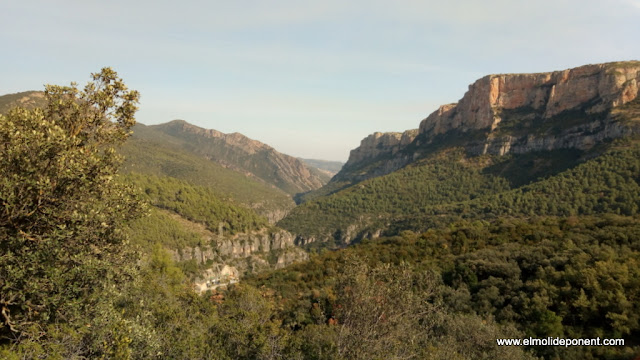The Camarasa tabac cave

Going to the tobacco cave is the quintessential Camarasa excursion. Its 300 meters of elevation gain and a little more than two hours of travel make it an ideal excursion for families with children, to do it in spring or autumn.

We left the car after the dam, heading towards Cellers. We go back, since the path leaves from the side of the dam. The path is very well marked. The first part passes through a shady and humid area, among lush vegetation, mostly shrubs. In the second, on the south side of the Mont-roig mountain range, the rock dominates. Here, we have good views over the Mu gorge, where you can see the Alós de Balaguer castle in the distance, and over the Leridana plain. The final part of the route is equipped with towbars, chains and iron ladders, via ferrata type that make the ascent a little difficult.
The cave is protected against vandalism with metal bars where there is a door with a combination lock managed by Espai Origens.
The large cave, 130 meters deep, 20 meters high and about 15 meters wide, is a karst formation with stalagmites and stalactites. There are also some very deteriorated Neolithic paintings. It is a good idea to bring a light so you can inspect the cave.
The Tobacco Cave was declared World Heritage by UNESCO in 1998.
This app allows us read the contents of the different QR codes that are arranged along the route that goes to the cave.







Translated from the Informational Poster
THE KARST
The Cova del Tabac is located in the municipal district of Camarasa, on the southern slope of the cliffs of the Mont-roig mountain range, shortly after the confluence of the Noguera Pallaresa River with the Segre River and about 300 meters above the river level.
The cave is approximately 15 meters wide, 20 meters high, and 80 meters long before changing direction to the north, continuing for about 110 meters more and ending due to a collapse of the ceiling. After the collapse, the cave continues for about 30 meters more, where the northern entrance is located, known as Cova del Pas del Sastre.
The Cova del Tabac (Camarasa) and the Avenc i Cova del Pas del Sastre (Les Avellanes i Santa Linya) are part of the same karstic unit, partially filled with clastic sediments from the floods that entered through the large opening of the avenc, eventually blocking the center of the natural tunnel and exiting through the Tabac entrance.
The cave is located within the Limestone Formation of the Mountains, with an age of approximately 70 million years (Upper Cretaceous). It contains marine fossils and is situated within the thrust sheets of the Marginal Mountains, one of the three resulting from the uplift of the Pyrenees towards the south.
THE SITE
The first reports of the Cova del Tabac were provided by Francisco de Zamora between the years 1785 and 1790 in the Diary of Travels in Catalonia. In 1880, Josep Pleyan de Porta referred to it as a dwelling from the Bronze Age. Lluís Marià Vidal conducted archaeological excavations in 1892 and 1893, recovering materials that would be studied and later published by other researchers such as J. Serra Ràfols in his work on the prehistoric settlement of Catalonia (1930) or J. Maluquer de Motes (1945).
The materials recovered by Marià Vidal indicate a long occupation of the cave with Neolithic elements and ceramics apparently characteristic of that period and later phases, including ceramic fragments, abundant querns, percussion tools, flint blades, a bone awl, shell bracelets, a boar's tusk, and many shells.
Some ceramic fragments are decorated with finger incisions, digitate cords, and garlands, while others feature incised decoration with lines and triangles. Vidal also mentions the presence of domestic and wild animal remains, as well as some human bones (parietals and skulls).
ROCK PAINTINGS
The rock paintings of Cova del Tabac were discovered in 1978 by Lluís Díez Coronel, who presented them in 1983 at the XVII National Archaeology Congress.
12 painted figures were identified: 1 curved line, 1 anthropomorphic figure that could correspond to an eye, 1 star-shaped figure (a circular element with 10 rays), 1 radiating rectangle, 1 quadruped, and various lines and remnants of indeterminate morphology. Based on the typology of some elements, such as the eye, star-shaped figure, and pectiniform figure, the paintings could be dated to the Bronze Age.
In 1986, the Service of Archaeology and Paleontology of the Department of Culture of the Generalitat of Catalonia carried out comprehensive documentation of the paintings as part of the "Corpus of Rock Paintings of Catalonia" project.
Within the research project "Human Settlement in the Eastern Pre-Pyrenees during the Upper Pleistocene and Holocene," conducted by the Autonomous University of Barcelona (CEPAP-UAB), two new painted figures were discovered in 2016 and are currently under study.
In 2017, the Service of Archaeology and Paleontology removed graffiti that directly affected the paintings and carried out their consolidation.






